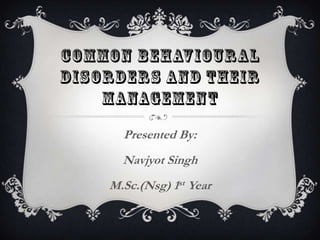
Common disorder
- 1. Presented By: Navjyot Singh M.Sc.(Nsg) 1st Year
- 2. INTRODUCTION Disruptive behaviors should be considered from both a developmental and a bio-psychosocial framework. A child who is not doing what adults want him to do at a particular time is considered as behavioral disorder.
- 3. DEFINITION A person is said to have a behavior disorder when he or she demonstrates behavior that is noticeably different from that expected in the school or community.
- 4. COMMON BEHAVIORAL DISORDERS Repetitive Behaviors Finger (thumb) sucking & Nail biting Temper Tantrums Evening Colic Stranger Reaction / Anxiety Pica Breath holding spasms Stuttering / Stammering
- 5. REPETITIVE BEHAVIORS Benign & self-limiting Begin between 6 – 10 years Example- Body rocking, Head banging Head banging In 5-20% of children during infancy & toddler years Can result in callus formation, abrasions, contusions
- 6. MANAGEMENT Assurance Teach parents to ignore – as concern and punishment can reinforce it. Padding
- 7. FINGER (THUMB) SUCKING & NAIL BITING
- 8. Sensory solace for child (“internal stroking”) to cope with stressful situation in infants and toddlers. Reinforced by attention from parents. Most give up by 2 years. Predisposing factors: • Developmental delay • Neglect
- 9. ADVERSE EFFECTS Malocclusion – open bite Mastication difficulty Speech difficulty (D and T) Lisping Paronychia and digital abnormalities
- 10. MANAGEMENT Reassure parents that it’s transient. Improve parental attention / nurturing. Teach parent to ignore; and give more attention to positive aspects of child’s behavior. Provide child praise / reward for substitute behaviors. Bitter salves, thumb splints, gloves may be used to reduce thumb sucking.
- 11. TEMPER TANTRUMS
- 12. In 18 months to 3 year olds due to development of sense of autonomy. Child displays defiance, negativism / oppositionalism by having temper tantrums. Normal part of child development. Gets reinforced when parents respond to it by punitive anger. Child wrongly learns that temper tantrums are a reasonable response to frustration
- 13. MANAGEMENT In general, parents advised to: Set a good example to child Pay attention to child Spend quality time Have open communication with child Have consistency in behavior
- 14. During temper tantrum: Parents to ignore child and once child is calm, tell child that such behavior is not acceptable Verbal reprimand should not be abusive Never beat or threaten child Impose “Time Out” - if temper tantrum is disruptive, out of control and occurring in public place.
- 15. EVENING COLIC
- 16. Intermittent episodes of abdominal pain and severe crying in normal infants Begins at 1-2 weeks age and persists till 3-4 months. Crying usually in late afternoon or evening
- 17. CAUSE Not known More likely if the child is over active and parents are over anxious Could be a manifestation of -hunger, -aerophagia, -immaturity of intestine, -overfeeding,
- 18. MANAGEMENT During Episode Hold the child erect or prone Avoid drugs Counseling - Coping with the parents Reassure the parents that infant is not sick They need to soothe more with repetitive sound and stimulate less with decrease in picking up and feeding with every cry.
- 20. By 6-7 months age infant can differentiate from primary care givers and others At this age they develop fear of others. This may last for a few months to peak around 13-15 months It might be an indication for later development of behavioral problem as separation anxiety.
- 21. MANAGEMENT Teach relaxation technique such as slowly exposing them to stranger, Initially from a distance Asking them to greet and slowly advance Reassure the parents that the behavior gradually declines But if persists, refer to child psychiatrist
- 22. PICA
- 23. Repeated or chronic ingestion of non-nutritive substances. It’s an eating disorder. Normal in infants and toddlers. Examples: mud, paint, clay, plaster, charcoal, soil.
- 24. PREDISPOSING FACTORS Parental neglect Poor supervision Mental retardation Lack of affection Psychological neglect, orphans) Family disorganization Lower socioeconomic class Autism
- 25. MANAGEMENT Screening for: Iron deficiency anemia Worm infestations Lead poisoning Family dysfunction Treat accordingly to cause.
- 26. BREATH HOLDING SPASMS
- 27. Behavioral problem in infants and toddlers. Child cries and then holds breath until limp. Cyanosis may occur. Sometimes, loss of consciousness or even seizure can occur. It is child’s attempt to control environment: parents/caregivers. Benign condition: no risk of epilepsy developing in later life.
- 28. MANAGEMENT Referral to Child Guidance Clinic. Referral to Child Psychologist – If BHS accompanied with head banging or highly aggressive behavior.
- 30. Defect speech Stumbling and spasmodic repetition of some syllables with pauses Difficulty in pronouncing consonants Caused by spasm of lingual and palatal muscles Usually begins between 2 – 5 years Reminding and ridiculing aggravate Child loses self-confidence and become more hesitant They can often sing or recite poems without stuttering
- 31. MANAGEMENT Parents should be reassured They should not show undue concern and accept his speech without pressurizing him to repeat Children should be given emotional support Older children with secondary stuttering should be referred to speech therapist
